Natasha's Dance (69 page)

FOLKLORE FANTASIES. The Rite of Spring
(1913): the original score by Igor Stravinsky.
Below:
Viktor Vasnetsov: set design for Mamontov’s production of Rumsky-Korsakov’s opera
The Snow Maiden
(Abramtsevo, 1881). Vasnetsov’s designs, with their folk-like use of colour, became a visual model for the Ballets Russes and primitivist painters such as Goncharova, Malevich and Chagall.
(1913): the original score by Igor Stravinsky.
Below:
Viktor Vasnetsov: set design for Mamontov’s production of Rumsky-Korsakov’s opera
The Snow Maiden
(Abramtsevo, 1881). Vasnetsov’s designs, with their folk-like use of colour, became a visual model for the Ballets Russes and primitivist painters such as Goncharova, Malevich and Chagall.
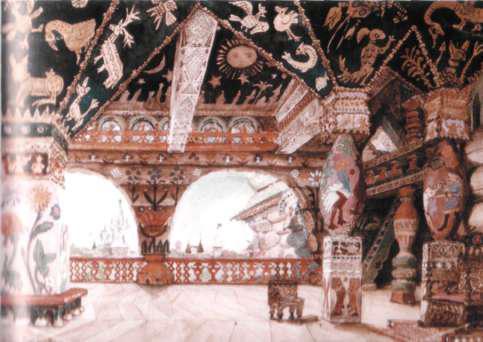
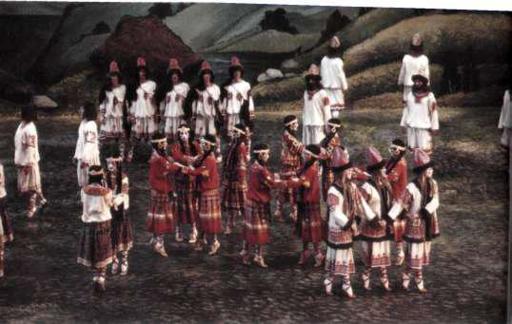
SCYTHIAN RUSSI A. The Rite of Spring
was conceived by Nikolai Roerich
was conceived by Nikolai Roerich
as the re-enactment of an ancient (‘Scythian’) ritual of human sacrifice. A trained
archaeologist, Roerich designed the sets and costumes
of The Rite of Spring.
These were
of The Rite of Spring.
These were
reproduced by the Joffrey Ballet for its revival of the original ballet in 1987 (above).
The rhythm of the music and the choreography emphasized the dancers’ weight and
immobility, a sense conveyed by Roerich in his many paintings of Scythian Russia.
Below:
Roerich:
The Idols
(1901).
Roerich:
The Idols
(1901).
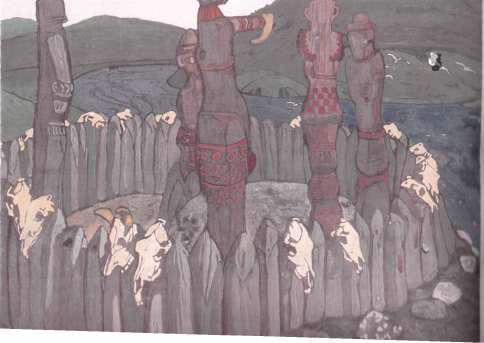
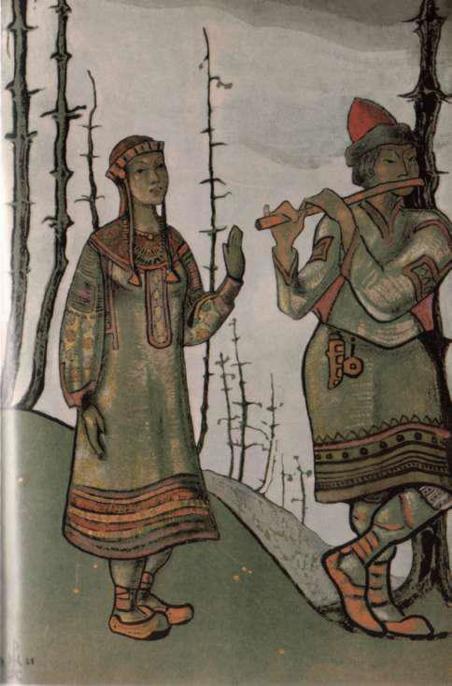
Roerich: costume designs for The Snow Maiden (Chicago, 1921). A disciple
of
Stasov, Roerich believed in the Asiatic origins of Russian folk culture, as
Stasov, Roerich believed in the Asiatic origins of Russian folk culture, as
suggested hereby the heavy jewellery and the Tatar-like headgear.
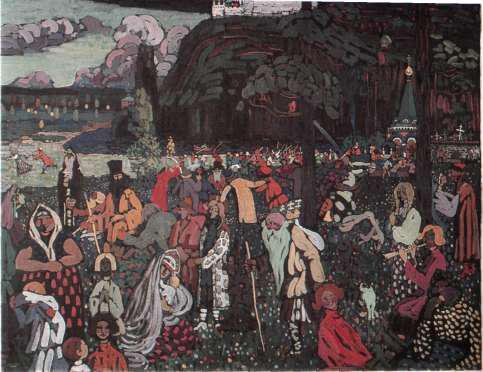
PAGAN RUSSIA.
Vastly Kandinsky:
Motley Life
(1907). Ostensibly a Russian-Christian scene, the painting is filled with pagan symbols from the Komi region, which Kandinsky had explored as an anthropologist.
Below:
Kandinsky:
All Saints II
(1911) tells the story of the confrontation between St Stephan and the Komi shaman Pam. Like
Vastly Kandinsky:
Motley Life
(1907). Ostensibly a Russian-Christian scene, the painting is filled with pagan symbols from the Komi region, which Kandinsky had explored as an anthropologist.
Below:
Kandinsky:
All Saints II
(1911) tells the story of the confrontation between St Stephan and the Komi shaman Pam. Like
Pam (seen escaping persecution in a boat) the two saints (standing on the rock) wear sorcerer’s caps but they also have halos to symbolize the fusion of the Christian and the
pagan traditions.

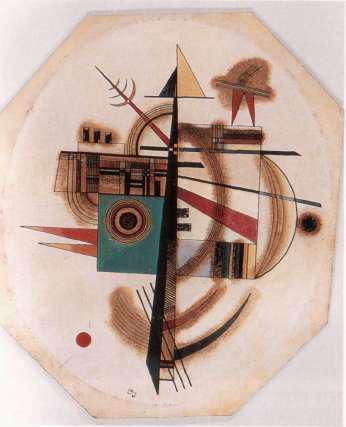
THE ARTIST
AS SHAMAN. Left:
Kandinsky:
Oval No. 2
(1925). The oval shapes and hieroglyphia of Kandinsky’s abstract paintings were largely copied from the symbols he had seen on the drums of Siberian shamans. A hooked curve and line symbolized a horse, circles symbolized the sun and moon, while beaks and eyes were meant to represent the birdlike headdress worn by many shamans for their dance rituals (below).
Kandinsky:
Oval No. 2
(1925). The oval shapes and hieroglyphia of Kandinsky’s abstract paintings were largely copied from the symbols he had seen on the drums of Siberian shamans. A hooked curve and line symbolized a horse, circles symbolized the sun and moon, while beaks and eyes were meant to represent the birdlike headdress worn by many shamans for their dance rituals (below).
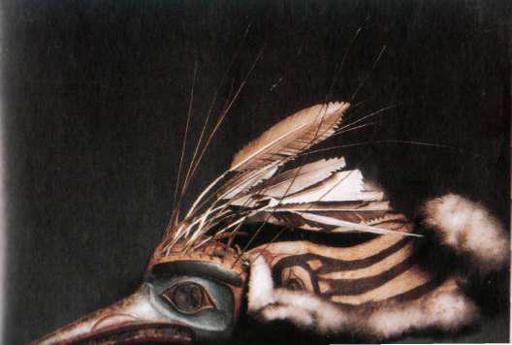

RUSSIA AND THE ASIATIC STEPPE.
Isaak Levitan
:
Isaak Levitan
:
Vladimirka
(1892). This was the road on which Russia’s convicts travelled
(1892). This was the road on which Russia’s convicts travelled
to their penal exile in Siberia.
Below:
Vasily Vereshchagin:
Surprise Attack
Below:
Vasily Vereshchagin:
Surprise Attack
(1871). An official war artist with Russia’s army on the Turkestan
campaign, Vereshchagin’s canvases were perceived as an attack on the
savage Russian violence against the Asian tribes.
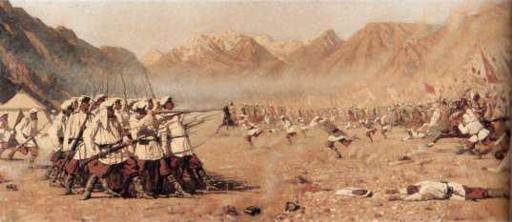
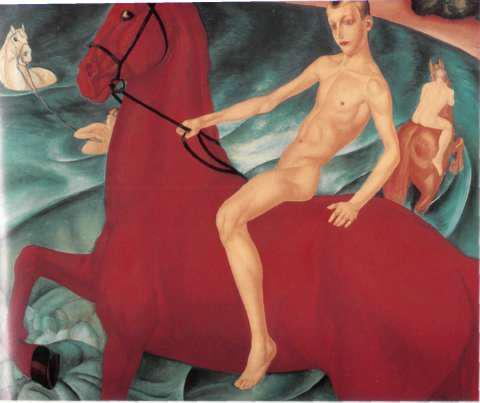
HORSES AND APOCALYPSE.
Prom Pushkin’s
Bronze Horseman,
the
Prom Pushkin’s
Bronze Horseman,
the
horse became the great poetic metaphor of Russia’s destiny and a symbol of apocalypse, Kuzma Petrov-Vodkin:
Bathing the Red Horse
(1912), a work strongly influenced by the Russian icon tradition.
Below:
Kazimir Malevich:
Red Cavalry
(1930).
Bathing the Red Horse
(1912), a work strongly influenced by the Russian icon tradition.
Below:
Kazimir Malevich:
Red Cavalry
(1930).
Other books
Usher's Passing by Robert R. McCammon
Pohlstars by Frederik Pohl
How to Love a Blue Demon by Story, Sherrod
Dreamquake: Book Two of the Dreamhunter Duet by Elizabeth Knox
Lady at the O.K. Corral by Ann Kirschner
The Grass Tattoo (#2 - The Craig Modern Thriller Series) by Catriona King
B00C8324IS EBOK by Forrest, Bella
Gods From the Machine by Andrew Ly
Dead Silence by Brenda Novak